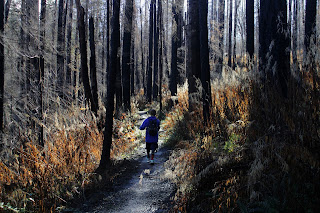
In the 1840's, gold was discovered on Coyote Creek, and the rush was on! Speculative prospectors flocked to the small creek and eventually the town of Golden sprung up in response to the sudden influx. Although two churches were constructed, amazingly there were no taverns or saloons in the town of Golden. Makes me wonder what they did on a Saturday night to blow off some steam. Anyway, a subsequent gold rush on distant Salmon River lured gold miners away from Golden. Chinese miners then moved in to mine Coyote Creek, but when the Salmon River gold rush went dry, the original Goldenites returned and drove out the Chinese miners. At its peak, Golden had a whopping 150 residents but by 1920, the post office closed and Golden was abandoned.
 |
| A forest sprouts on a pile of mining debris |
The ghost town then languished over the intervening decades and in 2011, the State of Oregon acquired the property and designated Golden as a
State Heritage Site. Several of the old historical buildings remain, including the Golden Community Church, and one can wander around and get a glimpse into Oregon's gold mining era. Across Coyote Creek Road, one can also get a glimpse of the dubious environmental "heritage" left by the very same mining history.
 |
| Wetland pond |
They did placer mining on Coyote Creek, meaning the alluvial deposits in the actual creek bed was mined for gold, and piles of mining debris are still clearly visible today. In 1993, a non-profit group managed the Coyote Creek area and I'm not sure if the site is still being managed by the non-profit group, Josephine County, the state, or none of the above. At any rate, ponds were created and hiking paths were installed and when I visited this area in 2011, I was impressed with the wetlands project. However, based on this visit, I unfortunately got the feeling that the wetlands are falling into disuse.
 |
| A two-holer made for social pooping |
I had an idea about leading a hike here for the hiking club and needed to see if I could squeeze 5 or 6 miles of trail out of the wetlands. Luna, my dog, didn't care about all that, she was just mindlessly happy to accompany her incredibly handsome master on a hike. We cruised through the old buildings and relics in the Heritage Site before crossing the road and walking into the wetlands. It was interesting to see a two-hole privy which always makes me wonder. I just can't imagine dropping a deuce next to another dude doing the same, but I digress.
 |
| Blackberry, going scarlet |
The path down to the first pond was in good shape and we startled some ducks who flew away in quacking panic. The pond was ringed with yellow-leaved willows, and blackberry vines were offering scarlet leaves to the gray sky. So far, so good!
 |
| Road next to Coyote Creek |
On the other side of the pond, a gravel road was our route down Coyote Creek. On my 2011 visit, paths ringed a series of ponds but today, the ponds were empty and the paths severely overgrown. So, we just followed the road, stepping around the frequent mud puddles in the way. Well, I stepped around while Luna happily frolicked through.
 |
| A mushroom emerges |
The wetlands have not been feeling the love lately and there was all kinds of trash strewn about. Signs are posted banning motor vehicles but you could see tire tracks on the piles of mining debris. There were even a couple of burned out autos rusting next to the creek. But it wasn't all bad, either. Coyote Creek was always nearby, mushrooms sprouted underneath the pines and firs, and there was still plenty of autumn color on the trees and shrubs.
I bushwhacked a little bit and found a berm where an old mining ditch had diverted some of Coyote Creek's flow back in the day. A pile of old boards was decaying nearby, indicating some kind of structure or building had collapsed here years ago. This trail wound up being about a 3 mile round trip amble, so I won't be returning here with the hiking club, it's too short of a hike. This walk wound up being more photo shoot than hike, but still, it was an interesting little peek into Oregon's past.
 |
| Coyote Creek |









































